Passion Plays
Passion Plays
– This article is based on information from: Stöckl, Spielleitung Christian. The Passion Play of the Community of Oberammergau. Germany: Oberammergau, 1990. It was adapted and expanded for this website by Father Johann Roten, S.M.
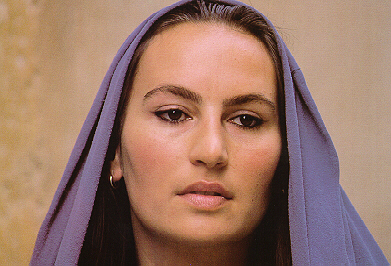
Mary: “O Simeon, Simeon, venerable old man. What you once prophesied to me will now be fulfilled: A sword will pierce your soul!” (Luke's Gospel 2:35)
Passion plays are related to medieval mysteries and highlight the events of the Easter triduum, usually from the Last Supper to the Resurrection. Local traditions introduced special features, for example, the descent into hell (Sterzing), the commissioning of the disciples (Frankfurt), the Cana wedding (St. Gallen) and even the representation of the fall (Maastricht).
There exists a certain similarity between Passion and Corpus Christi plays. Performed originally in Latin, vernacular languages take over between the thirteenth through the seventeenth centuries. Extant manuscripts show that there exist a great variety of Passion plays; for German-speaking regions alone we count approximately fifty different plays.
Since Passion plays habitually follow the biblical accounts of Christ's passion, Mary's presence is warranted especially at the foot of the Cross (John 19.25-27), sometimes also at the Cana Wedding (John 2.4) and for scenes from the Infancy narratives. There are, however, Marian scenes which are not based on Scripture:
Planctus Mariae (Mary's lament or complaint): Mary expresses her sorrow over Christ's Passion and death in a long poem or lament. In some plays Mary's lament follows immediately after Christ's death and the witness of the Roman centurion (St. Gallen), in others her planctus begins already during the Way of the Cross and is pursued after the death of Jesus.
Mary's pleading with Judas and Jesus: in some plays Mary pleads with Judas to spare Jesus' life or she pleads with Jesus to choose a different way to bring about redemption, a request Jesus must decline. Mary then accuses the angel Gabriel who declared her blessed among all women. The angel reminds her of Simeon's prophecy. But Mary visits and reminds Jesus of his obligation to the fourth commandment. He in turn draws her attention to His obligation to the Father in Heaven (Brixen).
Mary plays a role in the paschal events of Passion plays, especially in scenes where Christ appears to his mother. Sometimes this apparition is announced already at the Annunciation (Alsfeld).
In general, Mary's role in Passion plays is determined by elements from Scripture, apocryphal gospels and legends. Her role was coined during the period from the thirteenth through the sixteenth century and is strongly influenced by the history of spirituality and popular devotion during this time. There were plays and lists of actors where Mary did not appear.
Variations of Passion plays were known all over Europe, but this literary genre is not only a matter of the past. The Passion is still re-enacted regularly in many locations all over the world. In the USA, according to +Father. J. Kelly, a scholar on Passion plays, there may be as many as forty different plays. The most famous of all Passion plays is that of Oberammergau (Bavaria).
The "season" for passion plays is precisely the Lenten season even though some plays are put on stage much of the year and plays like Oberammergau really do not have a season. The Oberammergau community committed by vow to re-enact Christ's Passion at regular intervals. Thus, since medieval times the whole village of Oberammergau participates every ten years in the re-enactment of the play. Different versions of the play exist, among the more prominent ones are the so-called Rosner Spiel and the more traditional Daisenberger Passion. They have grave matters under consideration, for example, whether or not they will use the blood curse text of Matthew 27:25 even on a moderated scale as they did in 1990.
The 1990 version of the Oberammergau play was inspired by the Gospel of John. It has the following Marian scenes:
- Scene II Prologue: Jesus leaves his friends and his mother and his friends in Bethany. The departure from his Mother (shown at Bethany) is a moving scene (#3).
- Scene XII #1 Mary follows her Son on the way of the cross.
- Scene XII #6 The Virgin is with the disciple John in following the Accused.
- Scene XIII #5 Mary's presence is clearly seen as Jesus dies on the cross and is placed in his mother's arms.
Here are some recent images of Marian scenes from Oberammergau in 1990.
1. Tobias' Farewell (Symbolic Tableau, Reflecting and Anticipating Jesus' Departure from Home, and His Parents' Sorrow)
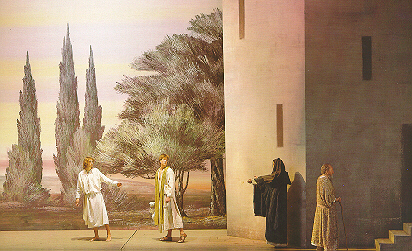
See how full of sorrow Tobias' Mother
Gazes at the son of her heart.
Even so the Mother of the Son of God weeps
Seeing her beloved Son with resolute steps
Going to wipe out with His love and death
The sins of mankind.
2. The Bride of the Canticle (Symbol of Mary-church and of All Faithful Calling and Seeking Christ, the Missing Bridegroom)
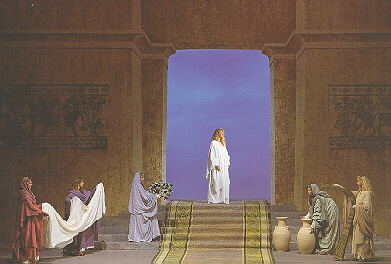
See the bride in the Song of Solomon,
How she weeps for the missing bridegroom,
How she calls and seeks, allowing herself no rest
Until she finds him.
3. Mary at Jesus' Departure
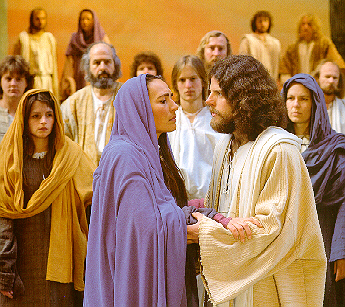
Mary: “My son, where shall I see you again?”
Jesus: “There, where the words of the scripture
are fulfilled: “He was led like a lamb to the
slaughter, and he opened not his mouth.” (Isaiah 53:7)
4. Mary and John at the Foot of the Cross
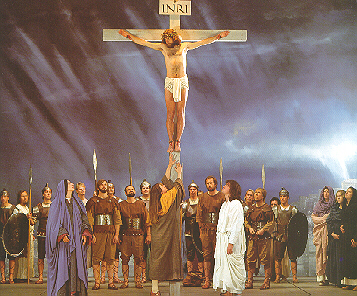
My God, my God, why have you forsaken me,
far from my prayer, from the words of my cry?
O my God, I cry out by day, and you answer not;
by night, and there is no relief for me." (Psalm 22)
5. The Pietà
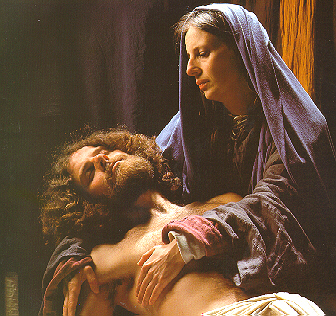
Mary: "Once before at Bethlehem, now at Calvary,
the part with the Father marked out for you is at an end.
My son, they have driven nails, through your hands and feet
and pierced your heart with a spear. Your sufferings and bitter
death went through my soul like a sword."
6. The Entombment with Mary, Jesus' Mother
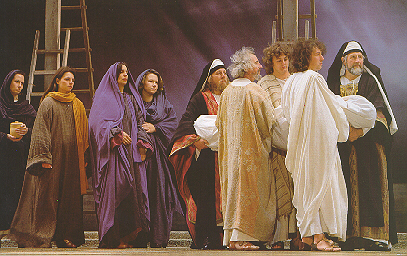
Joseph of Arimathea took the body down, wrapped it in fine
Linen, and laid it in a tomb hewn out of rock, in which no
one had yet been buried. That was the Day of Preparation,
and the Sabbath was about to begin. The woman who had
come with Him from Galilee followed along behind. They
saw the tomb and how his body was buried. (Luke 23:53)
Apparition of the Resurrected Christ to Mary and His Followers
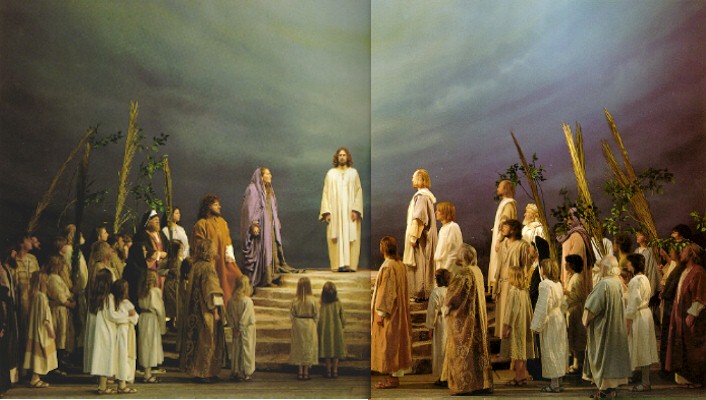
He is risen! Rejoice you heavenly hosts!
He is risen! Rejoice you mortals all!
The lion from the tribe of Judah
Has trodden down the head of the serpent.
Now He ascends to the highest glory
Where He will gather round him
All whom He has redeemed with His blood,
Where the eternal song of victory resounds:
"Praise be to the Lamb who was slain."
All About Mary includes a variety of content, much of which reflects the expertise, interpretations and opinions of the individual authors and not necessarily of the Marian Library or the University of Dayton. Please share feedback or suggestions with marianlibrary@udayton.edu.
